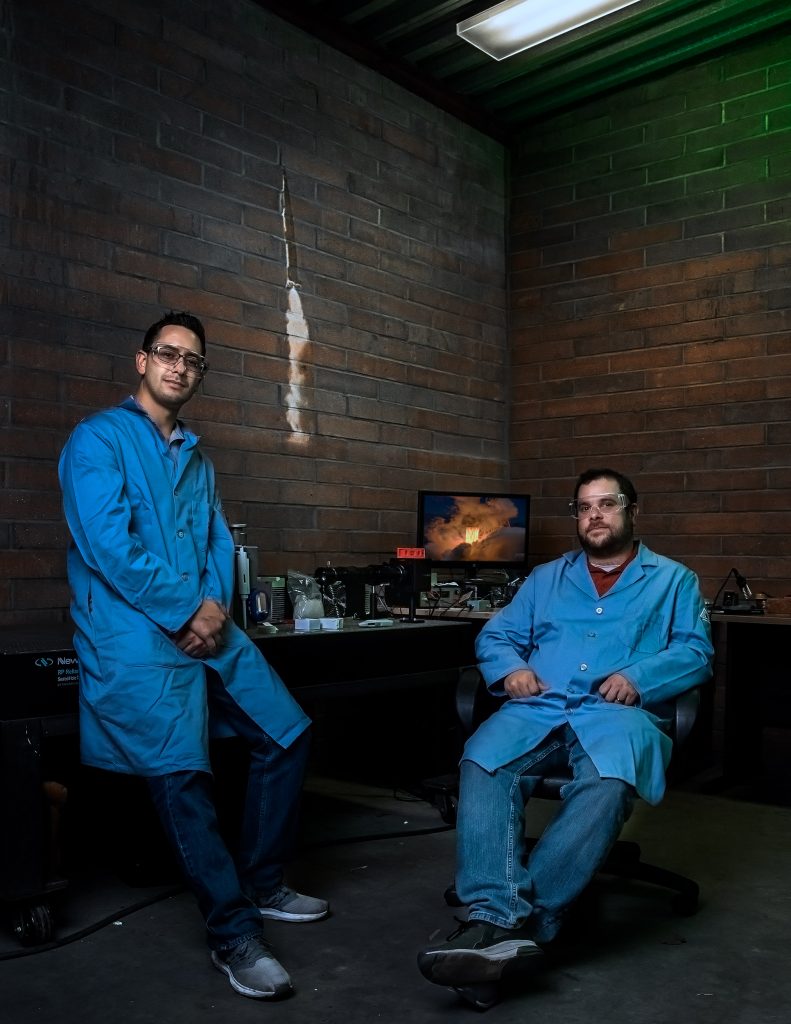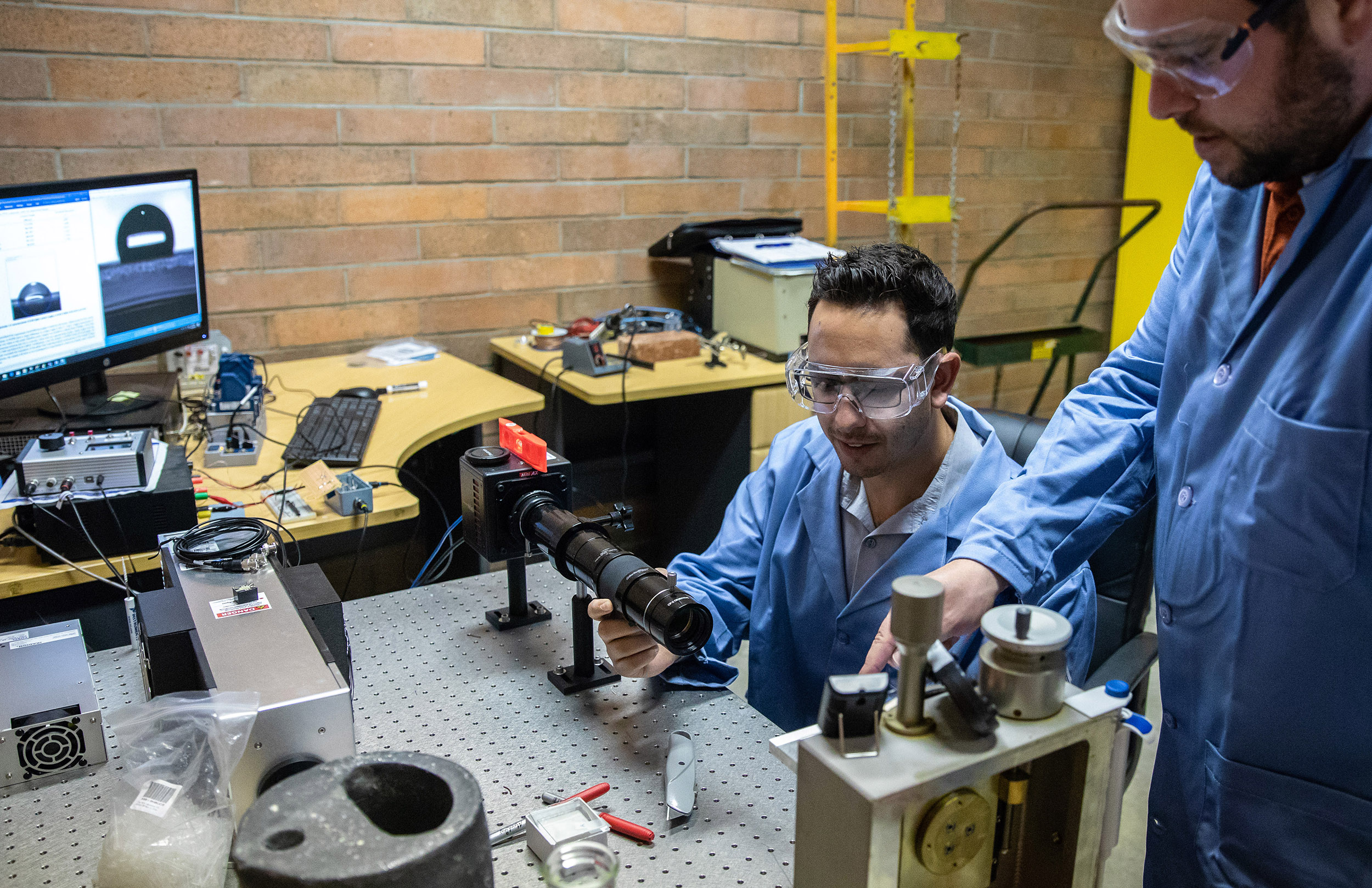Fuel Rewards
For Dr. Joseph Kalman and his students, the pursuit of knowledge is a mission to acquire a better understanding of energetic materials – the hot-burning stuff of solid rocket propellants, explosives and pyrotechnics.
Kalman, an assistant professor of Mechanical and Aerospace Engineering, is leading the establishment of an on-campus Solid Propulsion and Combustion (SPC) Laboratory, where he and other researchers will study the physical and chemical properties of solid propellants — or to put things more simply — what happens inside the rocket motor during the moments after ignition.
Kalman comes from the Naval Air Warfare Center Weapons Division at China Lake in California’s western Mojave Desert. His current appointment allows him to introduce students to the world of propulsion engineering.
The SPC lab will enable researchers to take a close look at what happens at the micro-level when energetic materials ignite, blazing to temperatures that Kalman said can approach 3,000 degrees Kelvin, which is close to 5,000 degrees Fahrenheit.
The Office of Naval Research provided a grant of nearly $400,000 to help the lab acquire equipment, so Kalman looks to have the lab fully equipped by June 2020 with such features as:
- CO2 laser, a device that is also used to cut or weld metal, for controlled ignitions
- Resonant acoustic mixer, which is an increasingly-popular device in the propellants industry that uses sound to mix thick, batter-like propellant ingredients.
- High-speed camera and optical devices to record, at minute resolutions and very high speeds, which help researchers understand how propellants react in a flame.
“It is crucial to have this lab on campus,” Kalman said. “If it is not on campus, our aerospace engineering students, and others, will not benefit from this equipment. We are in a hotbed of the aerospace and propulsion industry, and having students exposed to this work and equipment, with hands-on experiences, will give them a leg up from their peers at other schools.”

Alumnus Alek Nilsen, along with graduate student Christian Rodriguez and others, has worked with Kalman designing a slab burner to study how hot air interacts with solid fuel. Students are excited about the lab’s research possibilities.
One of their objectives is to better understand the functioning of a ramjet, a variant of an airbreathing jet engine. This kind of propulsion system allows a flying missile to channel surrounding environmental air into a combustion chamber. Missiles incorporating ramjets can have greater thrust and, thus, longer ranges than their more traditional counterparts, Kalman said.
For Nilsen, his research in the SPC lab is where he has pursued some of his most exciting studies.
“Usually school has been the hardest part and you’re just working on this thing. And then you start getting into the actual research here, and then all of a sudden all of those classes that you considered hard and the worst thing ever are now put on the side, and this is the priority,” he said.
The typical method of producing solid rocket propellants is something like baking a cake, Kalman said. Here, however, the main ingredients are an oxidizer (needed to begin/ sustain combustion), metal particles (for energy density) and a rubbery polymer binding agent that holds everything together. The ingredients can be mixed together and molded into the shape of a rocket engine.

That’s a basic description of the process, but part of the mission for the new laboratory is to explore the potential for more sophisticated fuel or propellant geometries. David Ramirez, an undergraduate student, is researching the science of 3D-printed rocket propellants at the lab.
Such propellants can be custom-made to burn at different rates after ignition, enabling propellant manufacturers to have more control over burn rates.
“The cool part about 3D printing is that you can customize what you want,” Ramirez said.
A missile powered by 3D-printed solid propellant, for example, could be designed to accelerate rapidly after being fired before slowing to a cruising speed and accelerating again before striking its target, Kalman said.
Working at the SPC Laboratory was an opportunity that aligned with both Ramirez’s aerospace career goals and interest in the underlying science of propulsion.
“My passion was always in rocket propulsion,” Ramirez said. “I grew up seeing the Space Shuttle Program and then, especially with the recent SpaceX reusable rockets, self-landing rockets, I was like, ‘That’s where I want to be.”
“I really wanted to get into the nitty-gritty science of it,” he added. “Why does it work? We can make these rockets, but why does this fuel act a certain way?”
Of course, potential applications are not strictly military in nature. If such a fuel is employed to power a rocket with a human passenger, the propellant could be designed to slow to a more comfortable rate of acceleration after escaping the earth’s gravity, Nilsen said.
The SPC lab is an investment in students’ futures and the future of aerospace engineering because it exposes them to real-world situations, Kalman said.
“Training students in this manner is important as a learning tool since they will understand how to attack a future problem while being safe,” Kalman said. “We cannot shelter our students from chemicals they will need to use in their careers. Part of my work/expertise is in combustion hazards, so we approach the problem head-on in a safe and educated manner.”
As for his decision to change his career direction, Kalman said “(At China Lake) you get to work on some very cool projects, but the research is more applied. I enjoy the basic scientific research a bit more, which is mostly done in academia. I’ve always enjoyed the teaching aspect, and having family in this area, it made Long Beach a great fit.”